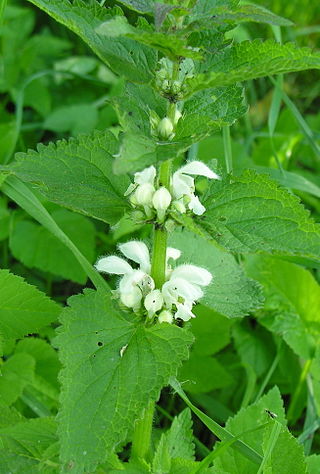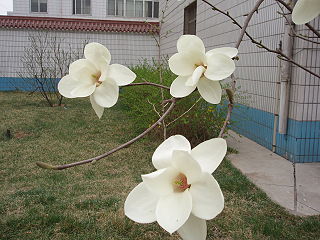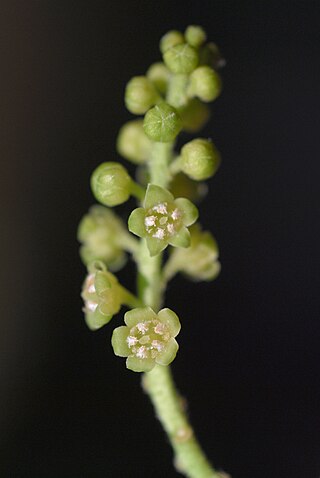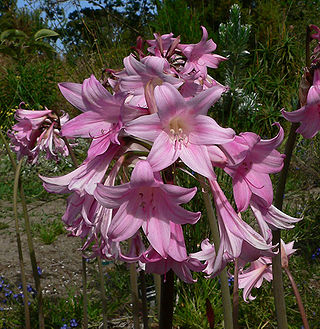
The Dioscoreales are an order of monocotyledonous flowering plants, organized under modern classification systems, such as the Angiosperm Phylogeny Group or the Angiosperm Phylogeny Web. Among monocot plants, Dioscoreales are grouped with the lilioid monocots, wherein they are a sister group to the Pandanales. In total, the order Dioscoreales comprises three families, 22 genera and about 850 species.
In biology, taxonomy is the scientific study of naming, defining (circumscribing) and classifying groups of biological organisms based on shared characteristics. Organisms are grouped into taxa and these groups are given a taxonomic rank; groups of a given rank can be aggregated to form a more inclusive group of higher rank, thus creating a taxonomic hierarchy. The principal ranks in modern use are domain, kingdom, phylum, class, order, family, genus, and species. The Swedish botanist Carl Linnaeus is regarded as the founder of the current system of taxonomy, as he developed a ranked system known as Linnaean taxonomy for categorizing organisms and binomial nomenclature for naming organisms.

The dicotyledons, also known as dicots, are one of the two groups into which all the flowering plants (angiosperms) were formerly divided. The name refers to one of the typical characteristics of the group: namely, that the seed has two embryonic leaves or cotyledons. There are around 200,000 species within this group. The other group of flowering plants were called monocotyledons, typically each having one cotyledon. Historically, these two groups formed the two divisions of the flowering plants.

Monocotyledons, commonly referred to as monocots, are grass and grass-like flowering plants (angiosperms), the seeds of which typically contain only one embryonic leaf, or cotyledon. They constitute one of the major groups into which the flowering plants have traditionally been divided; the rest of the flowering plants have two cotyledons and are classified as dicotyledons, or dicots.

Magnoliopsida is a valid botanical name for a class of flowering plants. By definition the class will include the family Magnoliaceae, but its circumscription can otherwise vary, being more inclusive or less inclusive depending upon the classification system being discussed.

The order Pinales in the division Pinophyta, class Pinopsida, comprises all the extant conifers. The distinguishing characteristic is the reproductive structure known as a cone produced by all Pinales. All of the extant conifers, such as Araucaria, cedar, celery-pine, cypress, fir, juniper, kauri, larch, pine, redwood, spruce, and yew, are included here. Some fossil conifers, however, belong to other distinct orders within the division Pinophyta.

Ranunculales is an order of flowering plants. Of necessity it contains the family Ranunculaceae, the buttercup family, because the name of the order is based on the name of a genus in that family. Ranunculales belongs to a paraphyletic group known as the basal eudicots. It is the most basal clade in this group; in other words, it is sister to the remaining eudicots. Widely known members include poppies, barberries, hellebores, and buttercups.

George Bentham was an English botanist, described by the weed botanist Duane Isely as "the premier systematic botanist of the nineteenth century". Born into a distinguished family, he initially studied law, but had a fascination with botany from an early age, which he soon pursued, becoming president of the Linnaean Society in 1861, and a fellow of the Royal Society in 1862. He was the author of a number of important botanical works, particularly flora. He is best known for his taxonomic classification of plants in collaboration with Joseph Dalton Hooker, his Genera Plantarum (1862–1883). He died in London in 1884.

Menispermaceae is a family of flowering plants. The alkaloid tubocurarine, a neuromuscular blocker and the active ingredient in the 'tube curare' form of the dart poison curare, is derived from the South American liana Chondrodendron tomentosum. Several other South American genera belonging to the family have been used to prepare the 'pot' and 'calabash' forms of curare. The family contains 68 genera with some 440 species, which are distributed throughout low-lying tropical areas with some species present in temperate and arid regions.
Plant taxonomy is the science that finds, identifies, describes, classifies, and names plants. It is one of the main branches of taxonomy.

Sympetally is a flower characteristic that historically was used to classify a grouping of plants termed Sympetalae, but this term has been abandoned in newer molecular based classifications, although the grouping has similarity to the modern term asterids.

A taxonomic system, the Bentham & Hooker system for seed plants, was published in Bentham and Hooker's Genera plantarum ad exemplaria imprimis in herbariis kewensibus servata definita in three volumes between 1862 and 1883.
In phylogenetics, a single-access key is an identification key where the sequence and structure of identification steps is fixed by the author of the key. At each point in the decision process, multiple alternatives are offered, each leading to a result or a further choice. The alternatives are commonly called "leads", and the set of leads at a given point a "couplet".
In biology, determination is the process of matching a specimen of an organism to a known taxon, for example identifying a plant. The term is also used in cellular biology, where it means the act of the differentiation of stem cells becoming fixed. Various methods are used, for example single or multi-access identification keys.

Gamopetalae is an artificial historical group used in the identification of plants based on Bentham and Hooker's classification system.

Inferae is an artificial group used in the identification of plants based on Bentham and Hooker's classification. Bentham and Hooker published an excellent classification in three volumes in between 1862 and 1883. As a natural system of classification, it does not show evolutionary relationship between plants but still is a useful and popular system of classification based on a dichotomous key especially for the flowering plant groups (angiosperms). It is the most popular system of classification based on key characteristics enabling taxonomic students to quickly identify plant groups based only on physical characteristics. However, it is not a scientific group and is used for identification purposes only based on similar plant characteristics. Under the system Inferae are a group of plants based on an artificial and non scientific series. The group Inferae are Gamopetalae and dicotyledons. The group comprises;

Heteromerae is an artificial group used in the identification of plants based on Bentham and Hooker classification system. Bentham and Hooker published an excellent classification in three volumes between 1862 and 1883. As a natural system of classification, it does not show evolutionary relationship between plants but still is a useful and popular system of classification based on a dichotomous key. It is the most popular system of classification especially for the flowering plant groups (angiosperms) based on key characteristics. This enables taxonomic students to quickly identify plant groups based only on physical characteristics. Under the system Heteromerae is a Sub Class, Series ii and it is often not used. The series comprises;

Monochlamydae is an artificial taxonomic group used in the identification of plants. It was largely abandoned by taxonomists in the 19th century, but has been often used since. Bentham and Hooker's classification, published in 1880, used this grouping, but stated that it was neither natural nor well defined, and that De Candolle's system was superior. Under Engler and Prantl's revision of 1931, the group Monochlamydeae was completely abandoned.

The Amaryllidaceae are a family of herbaceous, mainly perennial and bulbous flowering plants in the monocot order Asparagales. The family takes its name from the genus Amaryllis and is commonly known as the amaryllis family. The leaves are usually linear, and the flowers are usually bisexual and symmetrical, arranged in umbels on the stem. The petals and sepals are undifferentiated as tepals, which may be fused at the base into a floral tube. Some also display a corona. Allyl sulfide compounds produce the characteristic odour of the onion subfamily (Allioideae).
The Ranales are an obsolete taxon of the Dicotyledons, with rank of order typified by Ranunculus (Ranunculaceae).















